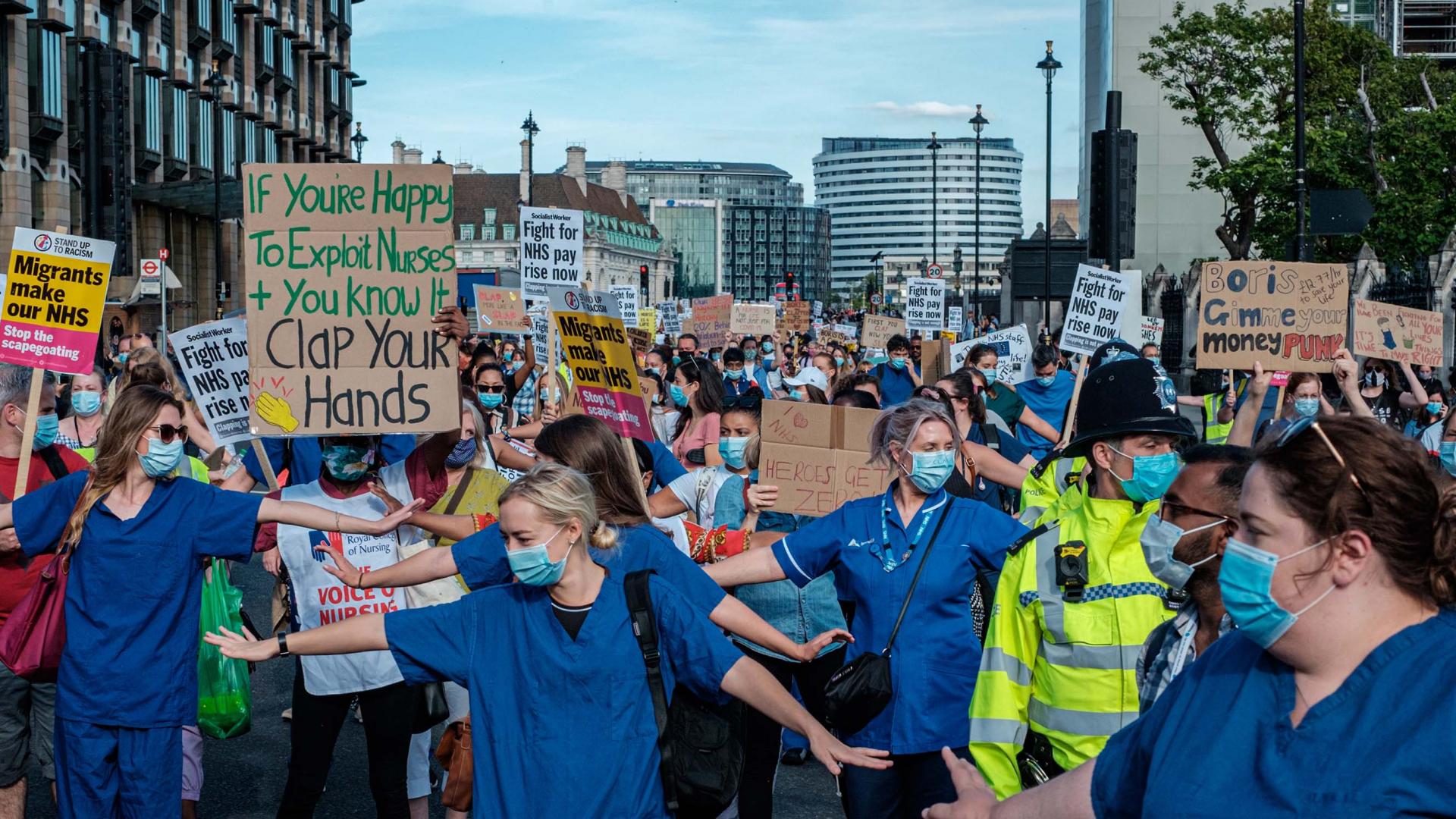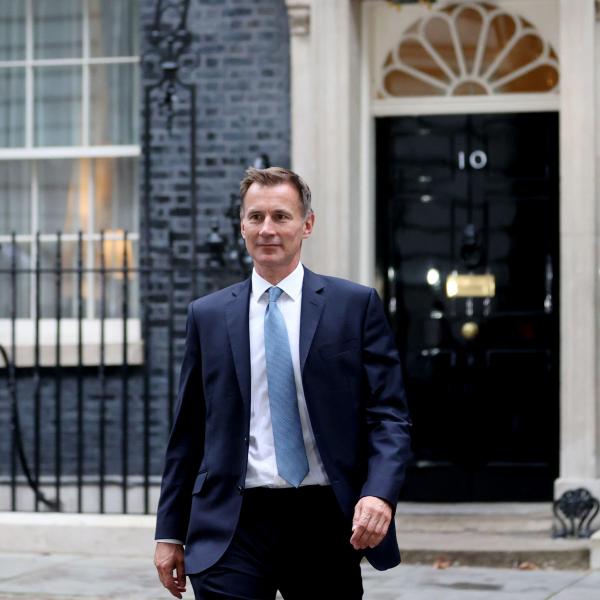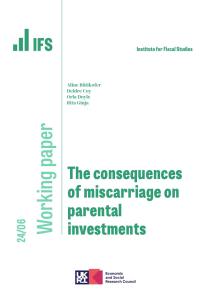
In this episode, we take a look at the state of the NHS across a range of areas.
Paul Johnson
Hello, and welcome to this edition of the IFS Zooms In, I'm Paul Johnson, director of the Institute for Fiscal Studies, and today we're going to look at the current state of the National Health Service, a big, big issue at the moment. How's it faring over this incredibly busy winter, looking at the waiting lists, the workforce, and in particular, whether there are reasons for hope things will improve, because as we know things are not going as well as they might at the moment. And to do that I'm joined by my colleague Max Warner, who's a researcher here at the IFS; and by Saffron Cordery, who's deputy chief executive of NHS Providers, who represent a whole slew of providers in the National Health Service including hospital trusts, ambulance trusts and mental health providers.
So, we know the NHS is all over the headlines at the moment and mostly not for good reasons. There are strikes, of course, and staff shortages, waiting lists have been growing very fast, the post pandemic recovery appears to be slow, people are staying in hospital longer than before, there's a huge number over the last year of excess deaths, not in the NHS necessarily, but across the population, and over the last few weeks and in the next few weeks, we've got more strikes from ambulance workers, midwives, nurses and so on. So, lots and lots to discuss about what's going on, why we're in this position and how, hopefully, things might, as I say, get better. Is there, is there hope?
So, let's start by just looking at where we are. The NHS is clearly going through a very tough winter, so Saffron first, perhaps you could just give us a sense of how is the health service performing at the moment when you think about the waiting list, the waiting times, the patient experience?
Saffron Cordery
Well, it's absolutely clear, isn't it, that the NHS is under extreme pressure, and whenever we talk to our trust leaders, whether they are chairs or chief executives of a big hospital trust, or whether they're the leader of a mental health service or a community service, they all say the same thing, which is that this has been the toughest winter they've experienced in their careers, and many of them have very long careers in the NHS. So, I think we know it's tough out there, you know we only need to look at the fact that last week's performance figures told us there was 94% bed occupancy across hospitals, so generally in acute beds, at 94% occupancy, that's an incredibly high level, gives us very little room for manoeuvre. One of the reasons that bed occupancy is so high is that we've got nearly 14,000 patients who are medically fit to be discharged but have nowhere to go, so that whole social care piece is incredibly challenging. And we also know that we got 1.8 million waiting to access mental health services. And critically, ambulance handover delays are really at a challenging level, and whilst they've come down very slightly, we know that those delays of over thirty minutes are still at around 18%, which is incredibly high. So, that paints a picture of some extreme pressure. And also, I'll just lob in there that of course workforce shortages are really a big issue with 133,000 vacancies across the whole of the NHS.
Paul Johnson
Well, there's a lot there to dig into, and we'll certainly come back to you on, I think, probably all of the points you've just made about you know, what, what, why, why have we got so many people who are ready for discharge who aren't being discharged? Why are we having so much problem with ambulance handovers and so on? But Max, perhaps you could paint us a little bit more, also, of a statistical picture of what we can see in terms of things like waiting lists and some of these other pressures, length of time people are staying in hospital?
Max Warner
So, the NHS is a very large complex system that provides lots of care, which means there's lots of different ways we can measure performance, but as Saffron was saying, I think the broad picture is things are worse than they were both pre pandemic, and actually relative to the NHS's own targets, which often weren't being met pre pandemic anyway. So, a few, kind of, numbers here, for example the waiting list for elective, so pre planned, not urgent treatment is at 7.2 million incomplete, pathways in November, that's up from 4.4 million prior to the start of the pandemic. 40% of those who've been waiting for treatment, have now been waiting longer than eighteen weeks, and that eighteen week is the kind of NHS constitutional standard, so that's not being met.
So, going in other places, for example ambulances, I think it's really stunning some of the ambulance delays, so in December last year, the average time for an ambulance to come for an emergency for like a stroke, something like that quite serious, was an hour and a half, compared with half an hour before the pandemic started. So, in lots of different areas we see kind of worsening NHS performance, in the data, as well as in the experience of staff as Saffron was alluding to.
Paul Johnson
It's looking, these, these are not good figures. But I mean the other thing that you, you see in the statistics, Max, though, is that this is all despite the fact that compared with pre pandemic, there are more staff, there's more money, so more resource going into the NHS than ever before, and yet this performance, which is so worrying.
Max Warner
Yeah, so NHS funding is about 11% higher in real terms this year than in 2019/20. As you say, we also have more staff, so even though staff are taking more sick leave on average, so there's higher kind of absence rates, even once you adjust for that, we see about 9% more senior doctors, 8% more nurses, so there's more staff and more money, that doesn't mean there's necessarily enough. There are also other resources that matter, so the number of hospital beds is about the same as pre pandemic, and once you adjust for the fact that there are still thousands of COVID patients, there are actually fewer hospital beds available for routine treatment, and then it comes to not just inputs into the system, but how well the system can process. And as Saffron was alluding to earlier, there's lots of different pressures that mean even if they're in maybe more inputs, they're maybe not being translated into the same number of patients being treated.
Paul Johnson
Okay, Saffron, so it would be great to just dig into some of that, I mean as was Max saying more, more money, more doctors and so on, but no more beds and, and, and quite a lot of COVID patients, is that the key constraint here?
Saffron Cordery
I think we have to look at a number of factors here, so I think it's obviously fair to say that more money is going in than pre-COVID, but we do know that everything costs more, we have an inflation factor here, which, which is something which won't account for all of it, but it is an important factor that we have to bear in mind. I think what we also have to remember is that what we saw with COVID was a situation where it exacerbated a number of pre-existing fault lines, and that's a really important point to remember. So pre-COVID we had workforce shortages, pre COVID-we had a situation where we weren't focusing as effectively as we could on managing demand. We've got demographic changes that have a massive impact. And we also know that the social care situation which I alluded to earlier when talking about those sort of delayed transfers of care, people who are medically fit for discharge who cannot leave hospital, has also significantly worsened, but these are all situations we had prior to COVID. So, I think that's one really important factor that we need to bear in mind.
The other thing that I think we need to focus on is the state of our NHS workforce overall, so we know that we now have an incredibly tired workforce that is, probably has lower morale and is sicker than it previously was due to all of the pressures that it's facing, impacted by the same things as everyone in the community is impacted by, including cost of living challenges. What does it mean when your money doesn't go as far? How does that impact your day-to-day life? What does it mean about whether you can afford childcare or not? Are you being lured away from the NHS into other settings which might pay more or be more amenable to flexible working and things like that? So, we've got an impact on the workforce.
I think the other bit that is really important for us to remember, and we see this a lot, not just in hospitals but also in other settings, is actually the impact of waiting a long time for treatment, and what that actually does to the severity and acuity of patients when they actually enter hospital. And I think we are seeing a lot in terms of length of stay being longer than it was previously. So even if demand held steady, if people are sicker and they need more treatment, then that's going to have an overall impact. So, those are a number of factors that we need to bear in mind, but I think the social care piece, and the inability to effectively discharge patients from whatever they're setting, whether it's a hospital, whether it's a mental health trust, is having a huge impact on the availability of beds, and capacity.
Paul Johnson
So, lots of issues there, workforce, inability to discharge because of social care, lack of beds, partly to do with additional COVID patients, a whole host of pressures from you know ongoing demographic change and so on, probably patients sicker than they were because they've been waiting for longer. On that last one, could I just ask very quickly, is that point about patients being sicker, I mean, do we have clear data on that, or is that speculation on the, you know, on the basis of your sort of understanding of talking to people across the service?
Saffron Cordery
I think it's more impressionistic than it is data at the moment, but there's a definite sense particularly if you look beyond the hospital setting, you can definitely see that. Talk to mental health trust leaders and they will tell you that their patients are coming in for longer than they were previously, or being sent out of area for treatment, which then impacts on their recovery and there is data correlating those two. So, we do know that across the piece, many trust leaders are witnessing that.
Paul Johnson
It's interesting, isn't it? I mean, you'd have thought that the NHS would have really good data on how sick its patients were but, but I mean, I've asked, I've asked lots of people this question, they all say the same as you, which is actually we don't have data on how sick they are, it's just that that's the impression I get from talking to people, it’s pretty surprising, isn't it?
Saffron Cordery
It is quite surprising, I think some of that comes down to the very transactional nature of data capture actually, so I think it's the, it's the difference between what people know and probably collect locally but what is then aggregated nationally and reported, it’s two different things. So, I'm sure if you, if you looked at say provider level data or system level data, there will be greater granularity there that we could look at, but we don't see it reported nationally.
Paul Johnson
It must be hard for NHS England to run a system where they don't have data on that most basic of things you'd have, you'd have thought. Perhaps that's one thing that we ought to recommend as a result of this addition of The IFS Zooms In, that the NHS actually collects the most important data that it needs to run the system, and maybe that's part of the problem. And Max, one of the things Saffron mentioned there was that people are staying in hospital longer than used to be the case. And again, I think some of your analysis has focused on that.
Max Warner
Yes, so we see the length of stay, particularly like people staying a long time, so three or more weeks, we do see that increasing. And we also see, as Saffron was saying, as a kind of simultaneous things, struggles discharging patients, so I think in December, for example, there are about 11,000 patients a day that were clinically ready to be discharged, but couldn't be discharged, and about three/four thousand of those had already been in hospital for more than three weeks. And I mean, even anecdotally having had a family member who was in hospital for maybe six/seven weeks unable to be discharged, so these two things are kind of happening simultaneously. I think the hard thing with a lot of this when we talk about data, is there's not sufficiently detailed data, we can see these are problems, but it's very hard to work out how big these problems are, where we should be prioritising, where we shouldn't. And I think just while we're on data, it's a really big issue here.
Paul Johnson
About the lack of good data across the system?
Max Warner
Yeah, so NHS England will, for example, have monthly data on every patient that's being treated, and can work out a lot of this stuff, but it's often not published, we're limited - there's a lot of data, but there's a lot more that could be released that would help people try and understand what's going on.
Paul Johnson
And do we think that that is understood and analysed appropriately within NHS England?
Max Warner
Well, we've spoken a lot with people both in NHS England and in the Department of Health, they're looking at these issues, but they often have the same questions we have, I would say.
Paul Johnson
interesting, I mean we shouldn't go down the rabbit hole of talking about data all the time, which is something that we at the IFS are very keen on doing, obviously.
Saffron Cordery
Isn't that rabbit hole your daily life?
Paul Johnson
Absolutely, we live down that rabbit hole, but we won't, we won't take our listeners, we won't take our listeners down there. I'm fascinated by this issue, Saffron, of not being able to discharge patients. Is it really that there just aren't the social care places available? I have heard people from within the system say that they think part of the issue, and I'd be really interested on your view on this, is that the system is often over bureaucratised, and there are too many steps to go through before people are allowed out, and they're not allowed out into family care when perhaps family care will be appropriate and so on. Or is it really, literally, that it's all working fine, but there's just nowhere in social care for these people to go?
Saffron Cordery
Well, I think we can never speak in terms of absolutes here, can we? So, the first thing I would say is that it's, I'm sure, a combination of many factors. I think the thing we have to remember is that in terms of the capacity to discharge patients, it is incredibly hard. That is partly to do with lack of social care provision, and I think we need to be clear here that that's not just care homes, that's also critically domiciliary care packages, which is what most people would want, obviously, to be discharged back into their own home or to their family’s home and be cared for in that setting. And we know that the care home and the care market is incredibly fragile and it's to do with the nature of the way that social care delivery is commissioned, and it causes huge challenges. So, it's very difficult to prop that market up, for example, and all of the measures that we see taken actually have a very disruptive impact on that market. So, things like mass buying of care home beds doesn't always help the care market situation, so we've got a very complex and fragile situation in terms of care.
We also have a less than robust kind of step-down setting for people to be discharged from, so things you know, intermediate care beds, rehabilitation beds, those kind of things, and we are seeing that being increasingly boosted because it's a very important step for people who need a bit of care, but don't need to be in a hospital setting to get them back to a place where they can then be discharged into their own home or into a care home, so that's another important bit. And that came out in the government's urgent and emergency care plan last week, which focused on how we boost that community support.
I think we have to recognise the extent to which workforce shortages are playing in here as well, so both in social care where recruiting and retaining staff is very hard when there are more attractive options available, whether it's you know retail or hospitality causes huge challenges. Similarly, in community services, particularly struck by the level of vacancies there, so you know, we know that staffing is also a challenge here. But if I could just go back to a point that Max made around length of stay, I think it's really important that we don't conflate length of stay, necessarily, with levels of unwellness or sickness, because we do know that actually lots of people who have extremely long lengths of stay in hospital, are waiting to be discharged, so they're the people waiting more than a month to get out, but they can't actually get out. So, they might not be incredibly unwell, so let's not just conflate length of stay with sickness. But overall, the social care and community services piece is incredibly challenging because we just need to be able to get people flowing through the system more effectively.
Paul Johnson
And I mean, is that your sense that we talked about, you know, ambulance waiting times and piling up waiting to discharge people and so on, is this essentially all about a flow through the system and it's all being driven by this inability to get people out at the other end? Or is there is there are there other things going on that are creating these problems?
Saffron Cordery
It is mainly that, I mean I think it's fair to say that that is the big challenge, the big blocker here, which is that the fuller the hospital is in terms of its general and acute beds, then the more challenge there is to actually admit people from A&E departments into the main hospital. That means that A&E becomes incredibly full, and once A&E is incredibly full, it's unable to take on the patients who are arriving, in what it feels like in their droves by ambulance, in into that setting. So, we've seen lots of work around, so we have seen both in terms of the discharge piece, we have seen lots of focus now on things like discharge lounges which lots of trusts have been doing for a long time, which is kind of moving people directly out of their beds and in somewhere from where they can be discharged. We are also seeing lots of efforts to focus on avoiding admission as well, and that's an absolutely critical piece.
I think the other thing to lob into this is the fact that what we see from ambulance services is that they do a lot of that admission avoidance work themselves, as well. So, they are doing everything they can to avoid conveying a patient to hospital because they know that once they are there they could be tied up in a very long way, and it's not good for ambulance services, but it's critically not good for patients to be admitted if they really don't need to. So, they will do a lot of the see and treat work and look after people in their own homes, that takes a really long time compared to what we've seen previously where people are simply picked up from their homes taken to an A&E department and offloaded. So, there's lots of complex factors in here which come together to basically also impact the capacity of the ambulance service to convey as many people as it really needs to meet demand, but they are doing a very good job in the process of keeping people out of hospital.
Paul Johnson
It's very striking how complex this system is, and you wouldn't think that struggling to get someone out at one end would be what's causing you to have to wait for a couple of hours outside A&E at the other, but that's clearly part of what's happening here.
Saffron Cordery
I was reading something yesterday, which was this a 1% increase in delay transfers of care, I think correlates to something like a 5, I think somewhere between 5 and 7% increase in bed occupancy, and so there's a really interesting relationship there.
Paul Johnson
So that needs to be fixed. There's some good news, isn't there, Max on the waiting list front, at least, in that some of the very longest waits are coming down in line with government targets?
Max Warner
Yeah, so last year, almost exactly, NHS England published its plan to get on top of the elective backlog, the kind of very long waiting list, that had a lot of different targets. The one that's actually passed so far was that by July of last year, they wanted to eliminate waits of over two years, and they've been very successful, in our view, of actually doing that. The number of people waiting over two years for care, which is an incredibly long period of time, essentially no one was pre pandemic, that's gone down by about 95%. They're about, in the latest data in November, there's about 1000 people waiting. Now that's a big number still, but it it's a lot better. And I guess more broadly, I think we're more optimistic in terms of the waiting list, that, in our kind of central view, at least waiting lists are likely to maybe flatline this year before starting the fall next year. There's a lot of uncertainty, but I think we're more optimistic than we were, say, a year ago.
Paul Johnson
And you're more optimistic, partly, because we've sort of given up on all these people who didn't get treatment during the pandemic, it just doesn't look like they're coming back.
Max Warner
Yeah, it's really remarkable. So, we, by our estimates, there may be 7/8 million people who would have been referred onto a waiting list during the pandemic, and they weren't because of all the disruption. And ourselves, and everyone who was thinking about this in the first year or two, from 2020 thought, well, most of these people are going to return, they're going to need care, and that's how we and others generated forecasts of waiting list to like 15/13 million. But that hasn't happened at all, if anything right now, there are fewer people joining the waiting list than there were pre pandemic. So, that's amazing for waiting list, that's really kind of saved the NHS, this year they've struggled treating people from the waiting list, but because not that many have been joining, you know they haven't ballooned. But I think there's really important questions about where are those patients? Are they getting the care they need? Some of it is changes in referral behaviour, some of it is changes in, for example services that allow GP's to treat people without going via hospital. Some of it could be very good, but I think there's still a risk that some of those people still need care and aren’t getting it.
Paul Johnson
I just want to repeat that actually for the benefit of listeners, it is an astonishing fact the, if anything, the number of people joining NHS waiting lists is now lower than it was pre pandemic, not by very much, but it's certainly not higher than it was pre pandemic, despite the fact that 7 or 8 million people missed out on treatment over those pandemic years, and we would have expected those numbers to grow. So, the reason that NHS waiting lists are going up is all of the reasons we've just discussed, about problems getting people out at the other end, about problems with workforce about problems with lack of increase in number of beds, it is not that more people have come on to the waiting lists. And there is this worry in the background, isn't there that, what what's happened to this 7 or 8 million? Did I mean, are they getting iller and iller? Did they not really need the treatment? What it's, I mean, could you throw any light on this, Saffron?
Saffron Cordery
I'm not sure that I can, I'm afraid. I think that it is deeply worrying. I remember at the height of COVID being really perplexed by that figure of, I think it's about 30% of those we expected to see an A&E just didn't materialise, and that's on top of the 30% who just decided not to because they didn't really actually need A&E departments, which is a good thing. So, people moderating their behaviour and using other routes is really welcome. But then there's the other 30% who can't possibly have not been having strokes and heart attacks and other very serious conditions, who simply did not materialise. And I think that is deeply worrying and it's the kind of worry that that we maintain right now during the industrial action where, actually, day on day, the industrial action has a bit of a chilling effect on demand, which you could say in one sense is a good thing, but it also has a knock on effect in terms of what's actually happening to those people who should be accessing care who aren't.
Paul Johnson
Well, that's a very useful segue into what I want to be the second half of this conversation, which really is focused on the NHS workforce. I mean, we've just talked about waiting lists and struggles with A&E and ambulances and all those sorts of things, but of course the other thing that we're experiencing at the moment is a wave of strikes across the service nurses, midwives, ambulance crews, and so on. Let's start Max, if you could just kind of just give us the sort of background in terms of pay here, I mean let's take nurses as the representative group, but in fact the sort of whole agenda for change workforce follows a similar kind of pattern. What's happened to the real, in other words inflation adjusted, earnings of nurses over the last year and over the last fifteen years or so?
Max Warner
Yeah, so it's a really important question and I think you're right to separate out what's happened in the last year. So, if we start there, in the last year, nurses and most NHS staff excluding doctors who are on agenda for change as you say, received pay awards averaging about 5%. That's at a time when, of course, inflation is running more like 10%, so that's a, just in a one year quite a big reduction in real pay. And actually, throughout this period it tends to be that those on the lowest incomes are getting more than those on the highest incomes, so there's some sort of pay compression going on, both at that point. And then when we take the longer run view again, we do see that real terms pay for lots of these groups has declined over, say, the last ten years as part of the longer-term kind of civil service, public sector pay freezes, pay restraint that we saw over the last ten years. So, it's certainly true that pay is in real terms lower for lots of these groups both this year and actually over a longer horizon.
Paul Johnson
And Saffron that pay squeeze is in the end what's behind the strikes?
Saffron Cordery
Absolutely, and I think what we have seen is industrial action, which is entirely focused around a pay deal which did not reflect that big jump in the cost of living this year, alongside other very important concerns and worries around other terms and conditions, but also about the broader state of the NHS, I think it's fair to say that this industrial action is also a commentary on how it feels to be a member of the NHS workforce on the frontline at the moment, and the pressures that they are juggling. And you know the phrase ‘moral injury’ is often used to describe that sense of actually having to work in circumstances that feel right at the edge of risk in terms of staffing levels, and other conditions. So yes, it's about pay, but it's also about wider factors as well.
And I think there is a COVID factor in this as well, which is a workforce that has been through an awful lot, has personally risked an awful lot, is incredibly tired and has come out of a wave of an infectious disease that we didn't know how to treat, and looked like it was going to put the population at peril, into a situation where the work is relentless and we've now got the pandemic of waiting lists essentially and demand in a different way. So, it's an incredibly tough situation out there, but I think that the genesis of this dispute comes from rising costs and rising disgruntlement at terms and conditions and what it feels like to work on the frontline.
Paul Johnson
I mean can I ask you a bit more about the sort of management of staff in in in the health service? If you look back at the 2019, so pre pandemic NHS long term plan, there's quite a number of quite surprising statements in there about, which one could sum up as saying the NHS really is not a very good employer, and I think quite a lot of staff feel that, I mean, it's a quarter of staff experience, harassment or bullying in the last twelve months, disjointed planning, many of those leaving would stay if they could develop their careers, not training sufficient nurses. There's all sorts of problems, longer standing problems about management of the workforce. So, would you accept that and would you, I mean is that part of what's going on here?
Saffron Cordery
I think that when we have, over the longer term, a lack of investment across the NHS in different ways, and we, that goes alongside increasing demand and huge pressures. And then we know that with a massive workforce, you've got a huge job on your hands to make sure that everyone is the best possible manager and leader that they need to be, I think that it is a big ask. I think this plays into a lot of what, the review that was carried out by Sir Gordon Messenger and Dame Linda Pollard, about what was needed really to reform the culture in the NHS and actually focus on what's needed for really effective leadership, and one of the big recommendations for them was actually for line manager training. So, how do we get those middle managers and lower managers actually to be as effective as they can? Because the one thing we know is that most people will leave their role because of a line manager, they're not leaving their job, they're leaving their manager. So, we've got a lot to do, a lot of work to do to actually focus on that.
And I think that it's fair to say that the NHS is probably one of the most surveyed workforces we have. So, we have really good comprehensive data about how staff feel about their roles, which gives trusts a lot to work with and a lot to work on, and it does bring to light bullying, harassment, racism, sexism, homophobia, which fundamentally needs to be tackled, but we have the data there. You know, we ask those open questions and we have the data there in order to work on. But I think pressurised workplaces like frontline care do make those day-to-day working relationships incredibly strained and incredibly difficult. So yes, there is a long way to go, but I think there are also some really fantastic leaders out there doing everything they can to wrap their arms around pretty big workforces working in difficult circumstances.
Paul Johnson
So Max, is there anything else that the data tells us about the problems in the workforce, whether it be pay or other issues?
Max Warner
Yeah, just picking up actually on something Saffron was saying about the importance of line managers, I think something that's really remarkable to me, as comparing workforce now to where we were pre pandemic, is all these clinical staff groups are much bigger, senior managers, much bigger, there are actually fewer of these mid-level managers. And I actually think that's part of the story maybe on workforce, but also on these wider productivity issues, actually, is there a question of is there enough mid-level management? We often hear bad things about NHS managers, but you know, there's a, they've got a key role in getting keeping the system working and helping with workforce, I think there's a really interesting question there as well.
Paul Johnson
And indeed, the NHS has relatively few managers compared with most health systems, and there's pretty good evidence that, if anything is under managed, not over managed.
Saffron Cordery
Absolutely.
Paul Johnson
And it's partly an absurd political rhetoric about bureaucrats and so on, this is a vast organisation and incredibly complex organisation, and it needs leadership and it needs management and without that it's not going to, it's really not going to work very well, in some places it clearly isn't.
Saffron Cordery
The other point to make is that we have to remember that the NHS is rightly one of the most closely regulated industries that we've got, you know it's a safety critical industry, it's highly regulated. But also I'm going to use the word suffers from, a degree of what one might call interference from various levels in in the political hierarchy, in the government hierarchy, in a way that can often thwart local initiatives. If you're trying to tick all of the boxes in terms of central initiatives and what's being pushed out centrally, it makes the freedom to manoeuvre in your local organisation much more challenging, and sometimes we know that those very locally determined actions are the ones that could have greater impact. But it's incredibly hard to find the space and the bandwidth to be able to pursue those when we've got a government and a bureaucracy which is all over every part of the running of the NHS.
Paul Johnson
There's quite big differences between different areas and trusts in performance though, I mean is, what's the problem there? Why isn't best practise moving from one place to the next?
Saffron Cordery
I would say that best practise does move from one place to the next. I think that what we have to remember is that, and this may sound a little trite, but I'm going to say it anyway because I think it’s true is that certainly what works in Hampshire, doesn't necessarily work in Hartlepool, for example. And I think you do have to remember that that setting and circumstance can make a huge impact. So, we know that places that have poorer performance often are the places that struggle to recruit. So, we know that in very remote rural locations, it's much harder to recruit the highest quality highest calibre staff, in fact, it's hard to recruit staff full stop. So, we do know that there will be challenges there where actually staffing levels aren't what they should be. That's a really important factor to bear in mind, which is that if you are in a big conurbation with a number of big hospital teaching trusts on your patch, with geographically adjacent organisations or learning off each other, competing with each other sometimes, but basically they're all in the fray together is a very, very different situation to somewhere that is incredibly remote, has one District General Hospital, and is really struggling in that way to get the staff on board. That’s part of the challenge we face, which is geographical demographic variation.
Paul Johnson
Okay, that's really interesting, big differences between the organisations, we often think of the NHS as a single organisation, which given that its scale I mean I think is just the wrong way to look at it. It's pretty much a whole sector of the economy, not far off the, it's about half the size of the whole manufacturing sector, isn't it? It's absolutely colossal. We should start to move towards the end of this discussion, but I think we can't do that until we've talked a little bit more about money, and Max you started off by saying that the NHS has got quite a lot more money than it had four years ago, but actually the speed of increase hasn't been particularly dramatic by historic standards, has it? And indeed, if anything, growth has been a little bit less than one might normally have expected, so how much of this is down to money?
Max Warner
Yes, so just some numbers on that, pre-pandemic - it's hard to compare funding because of COVID funding and lots of things in the middle, so, we tend to just compare 2019/20 to for example 24/25. Pre pandemic the planned growth rate there was in real terms about 3.4% per year, that is lower than the historical average over the last 50/70 years of about 3.6%. Higher inflation, as we've discussed, pulls that down quite substantially, and then there was some funding in the budget last year to top that up, and we end up getting to about a 2.9 percentage growth in real terms each year between 2019/20 and 24/25. So, that's lower than was planned, but has been slightly topped up. You know there's two things here, the NHS has more money in real terms, you know the NHS isn't being cut in that sense, but whether that's enough, and whether that's a fast enough growth is frankly ultimately a kind of political question about what do we want the NHS to actually provide. So, we can talk about the numbers, but what the right level is, I think, is much more of a kind of political question about what we want the NHS to do and how well we want to do it.
Paul Johnson
Again, that's a really striking set of statistics there I mean the key thing for me that you said there is that the growth over the period between 2019 and 2024 currently planned, once you take into account inflation, is lower than the plan back in 2019, before we had a pandemic. So, we had a great big pandemic in middle, and the outcome has been lower growth in spending than we were planning pre pandemic. Now that is, is pretty surprising, I suspect, to most people and pretty, a pretty striking fact, given that, as we've heard, that even ignoring the consequences of the workforce and so on of stresses through the pandemic, there are still several thousand people in hospital with COVID, so even back by itself you might think would lead you to want to spend more. Now, of course, that's down to the fact that inflation is so much higher, and spending numbers have been kept roughly where they were, as you mentioned, a little bit of a top up.
So, given all of that, Saffron, where's the room for manoeuvre? And particularly is there any scope to pay nurses and others more than currently being offered from within current budgets? What would happen if we tried to do that?
Saffron Cordery
Well, I think this is this is the absolute conundrum we now face in terms of pay and the industrial action because a 1% pay increase roughly equates to something like £700 million of budget, this is for agenda for change staff, so that's a huge chunk to take out of budget to spend on other services. So, I think that whatever happens in terms of the settlement of this dispute, the money has to be additional money, it cannot be taken from existing budgets, and I think this will become one of the sticking points that we start to see as, fingers crossed, we ultimately might see some negotiation on the industrial action and what's being asked for. But I do think that that that's a big challenge, it was a big challenge last year in terms of what we saw with the pay award that came out of the pay review body, so that award wasn't fully funded by government, NHS England had to find money from its budgets in order to ensure that that hit wasn't passed through to frontline trusts. But it did hit frontline services because NHS England had to delay its investment in things like digital transformation, in things like community diagnostics, all of which would add a whole degree of efficiency and boost productivity across the piece. I think the other point, just to mention, and this is just maybe take us slightly off topic, but the other bit that we need to think about is alongside the day-to-day spending on the NHS in terms of running costs, we also desperately need to see proper capital investment as well, because that underpins the ability of the NHS to be more efficient and more productive, and that's one factor that often doesn't come through in the conversation, so if you have to keep cancelling operations because the air conditioning doesn't work in your operating theatre, that doesn't help your underlying productivity at all.
Paul Johnson
Absolutely, and the capital spending backlog is becoming really very significant, isn't it? This is where it's so hard because the NHS is far and away the biggest thing that the government does, what it’s 180 billion budget, something like that. Absolutely vast, I mean you could have three ministry of defences for that, or you know four school systems or whatever the numbers are for one NHS. So, small changes in NHS funding might say well, it needs another 10%, but that's nearly another £20 billion, that's enough to fund entire government departments elsewhere, and that's why it's so hard. I mean we talk about increases of two or three percent a year not being enough, but that's billions and billions of pounds, and that, therein lies the big difficulty for government, but also the big difficulty for us the voters, because I think if we, in the end, if we want to spend more, significantly more on the NHS, there's no getting away from that costing us more in taxes down the line. I don't want to get into the whole discussion about the size of the state and the and the size of taxes, but that's the, that that's the world we're in because the NHS is just so big you can't do anything without actually moving the dial on the overall public spending numbers.
Saffron Cordery
Can I just also add that we can't dismiss the knock on effect on health services overall of having a local government sector that's been significantly disinvested in over the years, because that, really does undermine the investment, any investment in the NHS.
Paul Johnson
And that's because of social care?
Saffron Cordery
Not just social care, prevention, public health, those elements as well, which critically, if we want to keep people fit and healthy and out of hospital, we need, we need effective investment in public health services and we need effective prevention and we need, we need the kind of specific infrastructure of supporting the voluntary community sector that local government provides, and those safety nets have really fallen away because of the lack of funding for local government.
Paul Johnson
Yeah, and that's really important, central government needs to see this as a holistic system, and as we started to discuss, if the social care system isn't working, if you can't get people in that creates a huge problem right through the NHS. We're running close to the end, I'm looking at my notes, my last question is there any hope, essentially? Are there any signs for hope for the future? Max looking through the data is anything getting any better or are we, you know, are we in this forever?
Max Warner
So, I think there's a couple of things I'd want to say that are somewhat signs of hope. One is, as we discussed earlier, waiting lists, we think it's probably they're not going to rise that much more, fingers crossed, as long as things go roughly as we'd expect, I don't think they're going to rise significantly more, they're going to really kind of flatline and hopefully start to fall. That's good news. I think there are some areas, you know, we focus a lot on the big picture hospital stuff, there's some areas that have done quite well in the last year, and hopefully will continue to do so. For example, general practise actually has, last year had fewer GP's than pre pandemic, but we're still delivering more GP appointments. We've seen cancer, really quite almost concerningly successful increases in the number of people getting urgent referrals and urgent treatment, so vast increases there, which in some sense is good that the health service is performing well, might be concerning why that it would need to rise so much, but I do think there are glimmers of hope, and I guess as we come out of winter, the NHS has always struggled during winter, there should hopefully be some improvements. But in the longer term I think it does remain to see, one thing we're really worried about is that these COVID impacts, we're now several years into the pandemic, we're still seeing all of these huge impacts there's got to be a concern that this is something that's changed kind of permanent, and it's not just going to go away quickly.
Paul Johnson
Saffron your view on that, is this a long-term change that's going to be affecting the NHS for a long time? Or will we, will we revert to the sort of pre pandemic normal relatively soon?
Saffron Cordery
I think the challenges that are with us now are going to be with us for a significant period, all while we've got a situation where trusts, you know, trust have made huge progress on waiting lists, you can't underestimate that, against a backdrop of extreme challenges, they have been motoring pretty fast to get through the volume and the activity that they've got through. And that is really, really important. I think the bits of hope that I hold onto are one, some of the spirit of innovation and endeavour that that was created pre-existed the pandemic, but really came to the fore in terms of how people worked together the mutual aid, the mutual support we saw during the pandemic, and the innovation, I think that's very important. I think that we see hospitals, community services, mental health trusts all working really well within their systems, and I think that will gradually bed down, integrated care systems is a bit techie, but you know it's an important structural piece that that will ultimately bed down. So, I think I think there is some hope, and I also think that there is a bit of hope in the long term workforce plan which should be unveiled pretty shortly, because it will give us some sense of staffing levels that we need, and an indication to government of what it needs to stump up in terms of funding to actually support that.
Paul Johnson
Well, we could then have a long discussion as to why it's taken until now to get a workforce plan, but let's not go down there, there is hope, because finally, we're actually going to have a plan which might tell us something about what we need in terms of the workforce. The fact that it's, you know, getting through 2023 before we get there is something, as I say, we won't dwell on. We could talk an awful lot longer about all of the things you've just mentioned there, Saffron, including the role of integrated care systems and the management and leadership across the NHS and the structure, and all of those things, and maybe we'll come back to that in another episode, but I think we ought to leave it there, because you did say that there is hope, and I think that's probably the best.
Saffron Cordery
There’s always hope.
Paul Johnson
There's always hope, always hope, and we need it at the moment because clearly, you know, with waiting lists over 7 million , as I said earlier on, significant excess deaths, I'm afraid hospitals struggling to move people out into the community, strikes, a workforce which is tired and has had really big real terms pay cuts, problems in leadership and management, and a whole series of other issues across the NHS, there's plenty to worry about. But there is hope.
So, thank you for listening to this episode of The IFS Zooms In, to see more of our work do visit www.ifs.org.uk, and to further support us, do consider becoming a member for as little as £5 a month, you can find out more in the episode description. See you next time.
Listen now: Apple Podcasts | Spotify | ACAST | Stitcher | YouTube | Google Podcasts | RSS
With COVID, strikes, staff shortages, an enormous waiting list and an ever-ageing population (amongst other issues), the NHS is coming under greater pressure than ever.
How is the service doing at the moment? Will we see a pay settlement for nurses and other workers? And are there any reasons to hope that better days are ahead?
Joining us are Saffron Cordery, Deputy Chief Executive of NHS Providers, a membership organisation for NHS acute, ambulance, community and mental health services, and Max Warner, IFS researcher and NHS expert.
Zooming In: discussion questions
Every week, we share a set of questions designed for A Level economics students to discuss, written by teacher Will Haines.
1. If the NHS has more staff and more money, why is it under so much pressure?
2. What do we mean by a preventative approach to healthcare?
3. What are the short term and long term solutions to NHS provision in the UK?
Host

Director
Paul has been the Director of the IFS since 2011. He is also currently visiting professor in the Department of Economics at University College London.
Participants

Research Economist
Max joined the IFS in 2020 as a research economist in the Healthcare Sector, with a focus on the NHS labour force and adult social care in England.

Deputy Chief Executive NHS Providers
Podcast details
- DOI
- 10.1920/pd.ifs.2023.0003
- Publisher
- Institute for Fiscal Studies
More from IFS
Understand this issue

The NHS waiting list: when will it come down?
29 February 2024

Spring Budget 2024: What you need to know
7 March 2024

Retirement is not always a choice that workers can afford to make
6 November 2023
Policy analysis

Progression of nurses within the NHS
12 April 2024

Regional variation in earnings and the retention of NHS staff in Agenda for Change bands 1 to 4
10 April 2024

Recent trends in and the outlook for health-related benefits
19 April 2024
Academic research

The consequences of miscarriage on parental investments
22 March 2024

The menopause "penalty"
18 March 2024

Willingness to pay for improved public education and public healthcare systems: the role of income mobility prospects
14 March 2024